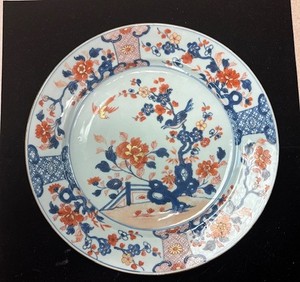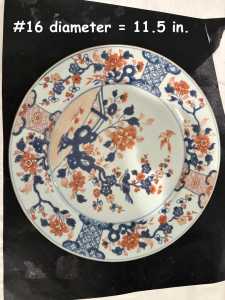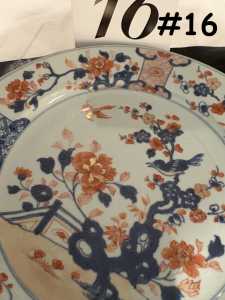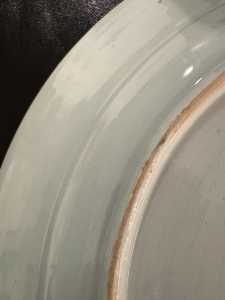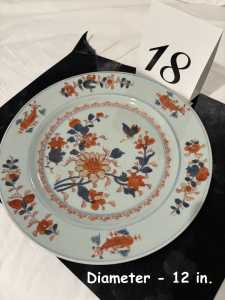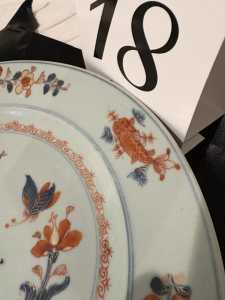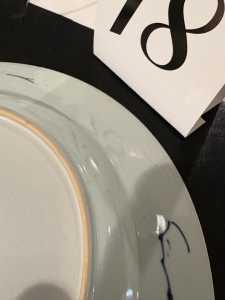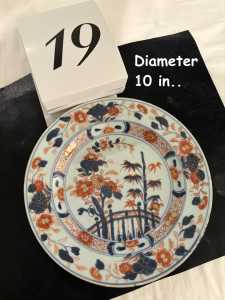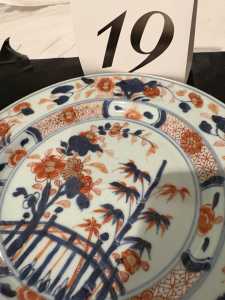The Chinese and Asian Art Forum. For Fans, Collectors and Dealers.
 Basic Rules For the BidAmount Asian Art Forum: Talk about whatever you want. You can even discuss and offer things that are for sale if they are authentic. Maximum image file size per post is 2 MB. Images of 700pxl x 700pxl are optimal if saved at a medium resolution. Be respectful of others and enjoy yourself. Click the YouTube link for a brief tutorial on using the forum. You can also EMBED Videos by cutting and pasting from You-Tube, Vimeo etc.
Basic Rules For the BidAmount Asian Art Forum: Talk about whatever you want. You can even discuss and offer things that are for sale if they are authentic. Maximum image file size per post is 2 MB. Images of 700pxl x 700pxl are optimal if saved at a medium resolution. Be respectful of others and enjoy yourself. Click the YouTube link for a brief tutorial on using the forum. You can also EMBED Videos by cutting and pasting from You-Tube, Vimeo etc.
NOTE: To post an item or add a new post, click open the category title from the FORUM LIST, and CLICK the Blue ADD TOPIC button.
I find what are called Kangxi imari plates particularly attractive. Are they Chinese fashioned like Japanese imari made in China during the reign of the emperor of the Quin Kangxi dynesty Feb. 6, 1661 through December 20m 1722 ? Is this a legitimate example shown here and if not what is it ? What is the Country and age and thank you very much.
Thank you for your opinion. My first photo was said to be less that optimally clear so I have posted more photos of it labeled #16. Also I have 2 others and would appreciate your opinion of these labeled #18 and #19. I think these are also 18th century Chinese Kangxi imari(1661 through 1722 ) or perhaps Japanese imari ! Please confirm or not. What is your opinion and others(Sharon, Julia, Mark etc.) can chime in becauise all your thoughts are instructive! Your opinion gives me confidence going forward.
.
The pictures are not the best here.
However on my opinion it's Chinese export ware and dates to the very late Qianlong period to the eariy 19th Century.
Mark
@icnvrs3rdaol-com Looks early 18th century to me, probably Yongzheng. My "Chinese Export Porcelain" book will have the evidence - I'll look it up.
According to Regina Krahl et al:
"The vast majority of the Chinese Imari-style date to the first half of the eighteenth century. The style came gradually to life in the first decade of the eighteenth century and the years of its greatest efflorescence were probably c. 1715-1735, when it provided a cheaper alternative both to the full famille verte enameled style, and to the famille rose, which succeeded this. . . Apart from occasional renewals of a more or less accidental kind the Imari style was largely extinct by c. 1745."
-Chinese Export Porcelain, p. 111.
PPS: More thoughts from the book:
-the spearhead pattern around the central scene of plate #18 reached the height of popularity in the 1730s and 1740s
-The Dutch continued to import Chinese Amari into the end of the 18th century; although most date from before around 1750, there are examples after that. It fell out of favor in England by 1760, although already imported ones were still being used in a few homes into the early 19th century, archeological evidence reveals.
@icnvrs3rdaol-com The only thing I know on Kangxi or more broadly 18th century Chinese is thanks to Peter and this Forum. I remember when I first found Bidamount on YouTube a video where in Peter said something about Kangxi being the period that most people were looking for at the moment. Congratulations on accomplishing the goal of 18th century Chinese. 👏
The object shown in the images is a Blue and White Dish with Overglaze Enamelled Floral Decoration, of “Zheyao” (Flaring-Rim) Form
I. Basic Information
Name: Blue and White with Overglaze Enamelled Floral “Zheyao” Dish
(“Zheyao” refers to a form with an everted rim and a slightly contracted mid-section, a vessel shape commonly seen in Ming and Qing porcelain.)
Dimensions: Diameter 11.5 inches (approx. 29.2 cm), a medium-to-large size example.
Decorative Features:
The center is outlined in underglaze cobalt, depicting branches and foliage, while the blossoms, fruits, and birds are rendered in overglaze iron-red (fanhong). The cavetto is encircled by geometric and floral bands. The palette is bold and contrasting, with dense yet well-structured decoration embodying traditional auspicious symbolism (e.g., birds and flowers signifying “prosperity and good fortune”).
II. Craftsmanship and Dating Assessment
Judging from the style and execution, wares of this blue-and-white with overglaze enamel type are frequently encountered in the Ming and Qing periods. The technique combines underglaze cobalt with low-fired overglaze enamels (such as iron-red or yellow), requiring the body to be fired first at high temperature, followed by a second, lower firing for the enamels—demanding precise kiln-temperature control and skilled workmanship.
Considering the complexity of the design and the characteristic diffusion of the enamels, the dish is tentatively attributable to a fine-quality folk kiln (minyao) product from the Kangxi to Yongzheng period of the Qing dynasty.
III. Collecting and Connoisseurship Notes
Value of Minyao Pieces:
Although minyao porcelain of the Ming and Qing dynasties was produced in large quantities and widely circulated, high-quality examples—those with refined decoration and well-executed craftsmanship—remain collectable. A blue and white dish of this type, if preserved in good condition, free from cracks or restorations, and retaining clear motifs and vibrant enamels, is generally well-received on the market.
Key Points of Authentication:
- Body (Tizhi): Qing minyao typically shows a compact, fine-grained body, usually greyish-white to creamy in tone, with a noticeable heft in the hand.
- Glaze: Genuine period glaze appears soft and lustrous, often with natural wear from use; modern reproductions tend to exhibit an overly bright, “glassy” surface.
- Markings: Some minyao wares may bear hall marks or auspicious inscriptions. The calligraphy should be checked for conformity with the period style. Many examples, however, are unmarked.
IV. Cultural Context
The technique of combining blue and white with overglaze enamels flourished during the Ming and Qing periods. It preserved the elegance of classic blue-and-white porcelain while adding a vivid polychrome quality through the enamels, making such pieces popular both as functional wares and as decorative household items. Dishes of the zheyao form were commonly used for daily dining or festive display. Their motifs—flowers, birds, geometric borders—reflect the aesthetic tastes and domestic culture of the times.
Chinese antique porcelain
Your dish is an export porcelain piece from the Kangxi period.
Chinese antique porcelain
Thanks for visiting "The BidAmount Asian Art Forum | Chinese Art"
If you sell on eBay, or have a shop feel free to post images and descriptions and links.
Check back often for discussion about the latest news in the Chinese art and antique world. Also find out about the latest Asian art auctions at Sotheby's, Christie's, Bonhams and Tajans.
Auction results for: fine porcelain, ceramics, bronze, jade, textiles and scholar's objects. As well as Japanese, Thai, Vietnamese and other Asian cultures.
Thank you,
Peter Combs
Topics and categories on The BidAmount Asian Art Forum | Chinese Art
Kangxi vases, Kangxi dishes and chargers, Kangxi ritual pieces, Kangxi scholar's objects, Qianlong famille rose, Qianlong enamels, Qianlong period paintings, Qianlong Emporer's court, Fine porcelain of the Yongzheng period. Chinese imperial art, Ming porcelain including Jiajing, Wanli, Xuande, Chenghua as well as Ming jades and bronzes.
The BidAmount Asian Art Forum | Chinese Art
A free Asian art discussion board and Asian art message board for dealers and collectors of art and antiques from China, Japan, Korea, Thailand, Cambodia, Vietnam and the rest of Asia. Linked to all of the BidAmount Asian art reference areas, with videos from plcombs Asian Art and Bidamount on YouTube. Sign up also for the weekly BidAmount newsletter and catalogs of active eBay listing of Chinese porcelain, bronze, jades, robes, and paintings.
The art of calligraphy - and for the ancient Chinese it certainly was an art - aimed to demonstrate superior control and skill using brush and ink. Calligraphy established itself as one of the major Chinese art forms during the Han dynasty (206 BCE - 220 CE), and for two millennia after, all educated men were expected to be proficient at it.
The Museum’s collections of Asian art span nearly five millennia and encompass the cultures of China, the Himalayas, India, Japan, Korea, and Southeast Asia. In 2007, the Museum launched an initiative to create dedicated galleries for the collection, beginning with a gallery for the arts of Korea ...
Chinese art is full of symbolism, in that artists typically seek to depict some aspect of a totality of which they are intuitively aware.
China Online Museum is the finest online museum of Chinese art. It features Chinese calligraphy, painting, ceramics, bronzes, carving, and other artworks.
Chinese Ceramics & Works of Art. Overview Upcoming auctions Contacts Auction results ... Christie’s sales of Chinese ceramics and works of art showcase centuries of Chinese history. Held throughout the year in London, New York, Paris and Hong Kong, they attract a wide audience of collectors and connoisseurs vying for pieces as diverse as ...
Explore Asian Art Week. Contact the Specialist Department. Chinese Paintings ... Senior Specialist, Head of Sale. [email protected]. Tel:+1 212 641 5760. Bid in-person or online for the upcoming auction:Fine Chinese Paintings on 10 September 2019 at New York. Bid in-person or online for the upcoming auction:Fine Chinese Paintings on 10 ...
Discover an abundance of must-see art from all corners of a vast continent at Christie’s NY Asian Art Week. From contemporary classical and Chinese paintings to works with exemplary provenance from the Art Institute of Chicago, our Rockefeller Paza galleries will be full of ancient treasures and contemporary masterworks in a salute to the vibrant arts of Asia.
Sold to benefit The Art Institute of Chicago’s Asian Art Acquisition Fund, the sale features 84 lots with a focus on Ming and Qing porcelains, and offers a rare insight into the taste for collecting Chinese ceramics and works of art in the Midwest from the end of the 19th century through the 1980s. Highlights include two Wanli wucai garlic-head vases, a Qianlong mark and period, blue and ...
Specialist, Chinese Paintings, Christie's London Dr Malcolm McNeill is a Specialist in Chinese Paintings at Christie’s, based in London. He previously worked as an assistant curator of the Chinese collections and the Victoria and Albert Museum in London, as a researcher at the British Museum, and as a translator and tour guide at the National Palace Museum in Taipei.
The Christie's Education 2020 Conference: The Chinese Art Market 18 Jun 2019 Christie’s Education is delighted to announce our first international academic conference in Asia which will take place in Hong Kong from 26-27 November 2020 at the Hong Kong Convention and Exhibition Centre and will run in parallel with Christie’s Hong Kong Autumn Auctions.
The summer Chinese Art sale in Hong Kong will feature works of art from several private collections, including Qing porcelains and textile from the collection of the legendary Chinese art dealer A. W. Bahr (1877–1959), fine gilt bronze Buddhist sculptures from an old Hong Kong collection, an East Asian collection of Qing dynasty wine cups and jades, and a Japanese collection of Song ceramics ...
Sotheby's Chinese Works of Art Department holds two auctions each year in London, New York, Hong Kong and Paris.
Chinese Art - View Auction details, bid, buy and collect the various artworks at Sothebys Art Auction House.
With more than 340 Chinese works of art dating from the Neolithic to the Republic periods, highlights of this sale include a selection of Qing Imperial monochromes from the collection of Arnold and Blema Steinberg, early ceramics from the Art Institute of Chicago and Chinese porcelain and works of art from the collection of Henry Arnhold.
Results: Sotheby's Asia Week achieved $52.4 million in six strong auctions, exceeding pre-sale estimates. With 76.5% of lots sold and 60.3% of lots surpassing high estimates, the Asian art sales at Sotheby's indicate continued collector interest in the finest works of art from China, India and and the Himalayas.
Today's sale of Important Chinese Art will proceed as planned with sessions at 10 AM and 2 PM EDT. Sotheby's will be monitoring the weather conditions throughout the day and will be available to coordinate alternative bidding options should conditions make it difficult for clients to attend the auction in person.
Bonhams Chinese Art department is renowned for offering the finest works of art representing the richness and breadth of China's artistic heritage, particularly Imperial porcelain, white and spinach green jades, cloisonné and Buddhist art. Specialised international auctions are held globally, including London, Hong Kong and San Francisco.
Bonhams : Chinese Works of Art We use cookies to remember choices you make on functionality and personal features to enhance your experience to our site. By continuing to use our site you consent to the use of cookies. Please refer to our privacy and cookie policies for more information.
Bonhams Fine Art Auctioneers & Valuers: auctioneers of art, pictures, collectables and motor cars. We use cookies to remember choices you make on functionality and personal features to enhance your experience to our site. By continuing to use our site you consent to the use of cookies. ... Chinese Art (US) General enquiries
Bonhams : Fine Chinese Art We use cookies to remember choices you make on functionality and personal features to enhance your experience to our site. By continuing to use our site you consent to the use of cookies. Please refer to our privacy and cookie policies for more information.
Bonhams Fine Art Auctioneers & Valuers: auctioneers of art, pictures, collectables and motor cars Bonhams : Asian Art We use cookies to remember choices you make on functionality and personal features to enhance your experience to our site.
Bonhams are international auctioneers of fine Chinese and Japanese art. We specialise in rare Imperial and Export Chinese ceramics and works of art, as well as Japanese ceramics, fine and decorative works of art from the Neolithic Period to the 20th century. View on map
Bonhams Fine Art Auctioneers & Valuers: auctioneers of art, pictures, collectables and motor cars. We use cookies to remember choices you make on functionality and personal features to enhance your experience to our site. By continuing to use our site you consent to the use of cookies. ... Asian Art Bonhams. Work. 22 Queen St.
